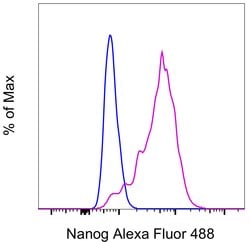Learn More
Invitrogen™ Nanog Monoclonal Antibody (eBioMLC-51), Alexa Fluor™ 488, eBioscience™
Rat Monoclonal Antibody
Supplier: Invitrogen™ 53576180

Description
Description: The eBioMLC51 monoclonal antibody recognizes mouse Nanog. Nanog is a multidomain homeobox transcription factor that has been shown to maintain pluripotency of embryonic stem cells, independent of LIF/Stat3. Expression of Nanog in the mouse is specific to early embryos, the ICM of the blastocyst, embryonic stem (ES) cells, and embryonic germ (EG) cells. Nanog expression often overlaps, but is not identical to, that of Oct4. Nanog is downregulated upon cellular differentiation and loss of pluripotency, making it a suitable marker in determining the undifferentiated state of stem cells. Nanog acts as a transcriptional activator and has two activation domains in the C-terminus, called CD2 and WR, and one activation domain in the N terminus. The CD2 domain is unique to Nanog, whereas the NK2 DNA binding domain is well conserved. Immunoblotting using eBioMLC51 reveals a band at ~ 45 kDa in F9 (an embryonal carcinoma cell line) lysate, but not in lysate from the NIH3T3 cell line or mouse spleen. Preliminary data using fluorochrome-conjugated eBioMLC51 suggests that it is essential to use the eBioscience Foxp3 Staining Buffer Set, Product # 00-5523-00, for intracellular staining of mouse Nanog. Applications Reported: This eBioMLC-51 antibody has been reported for use in intracellular staining followed by flow cytometric analysis, and immunocytochemistry. Applications Tested: This eBioMLC-51 antibody has been tested by intracellular staining followed by flow cytometric...
NANOG (Nanog homeobox) is a divergent homeodomain protein that directs pluripotency and differentiation of undifferentiated embryonic stem cells. NANOG mRNA is present in pluripotent mouse and human cell lines, and absent from differentiated cells. Human NANOG protein shares 52% overall amino acid identity with the mouse protein, and 85% identity in the homeodomain. Human NANOG maps to gene locus 12p13.31, while the mouse NANOG maps to gene loci 6 F2. Murine embryonic NANOG expression is detected in the inner cell mass of the blastocyst. Research studies have shown that high levels of human NANOG expression in the undifferentiated N-Tera embryonal carcinoma cell line. Further, NANOG is a transcription regulator involved in inner cell mass and embryonic stem (ES) cells proliferation and self-renewal. The role of NANOG in embryonic development suggested that it might be useful in the creation of stem cells that might be useful in cell replacement therapies in the treatment of several degenerative diseases. Artificial stem cells, termed induced pluripotent stem (iPS) cells, can be created by expressing POU5F1 (also known as Oct-4), another germline-specific transcription factor, and the transcription factors Sox2, Klf4 and Lin28 along with c-Myc in mouse fibroblasts. Experiments have demonstrated that iPS cells could be generated using expression plasmids expressing NANOG, Sox2, KlfF4 and c-Myc, eliminating the need for virus introduction, thereby addressing a safety concern for potential use of iPS cells in regenerative medicine. When overexpressed, NANOG promotes cells to enter into S phase and proliferation. Diseases associated with dysfunction in the NANOG protein include tetracarcinoma and germ cell/embryonal cancer.
Specifications
| Nanog | |
| Monoclonal | |
| 0.5 mg/mL | |
| PBS with 0.09% sodium azide; pH 7.2 | |
| Q80Z64 | |
| NANOG | |
| Affinity chromatography | |
| RUO | |
| 71950 | |
| 4°C, store in dark, DO NOT FREEZE! | |
| Liquid |
| Flow Cytometry, Immunocytochemistry | |
| eBioMLC-51 | |
| Alexa Fluor 488 | |
| NANOG | |
| 2410002E02Rik; early embryo specific expression NK family; early embryo specific expression NK-type homeobox protein; Ecat4; ENK; ES cell-associated protein 4; FLJ12581; HGNC:20857; hNanog; Homeobox protein NANOG; homeobox transcription factor Nanog; homeobox transcription factor Nanog-delta 48; Nanog; Nanog homeobox | |
| Rat | |
| 25 μg | |
| Primary | |
| Mouse | |
| Antibody | |
| IgG2a κ |
Safety and Handling
The Fisher Scientific Encompass Program offers items which are not part of our distribution portfolio. These products typically do not have pictures or detailed descriptions. However, we are committed to improving your shopping experience. Please use the form below to provide feedback related to the content on this product.

